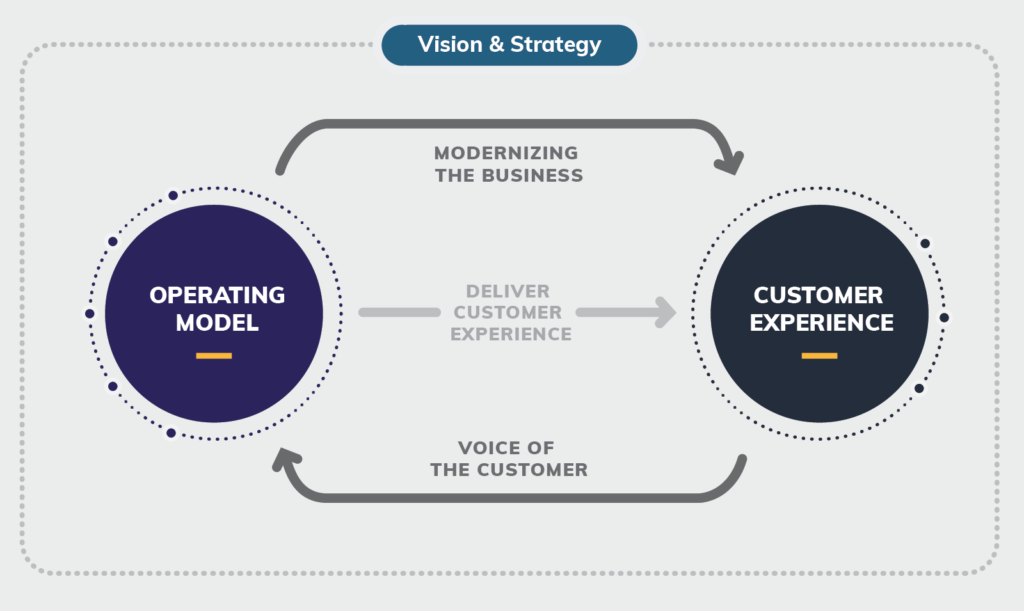Learn about the six components of becoming a digital-first organization so that you can make strides toward not only surviving, but thriving.
When the pandemic first hit, were you and your leadership team scrambling only to find that your business continuity plans were insufficient? Many companies quickly realized how unprepared they were to operate as a fully digital organization.
For example:
- They could not respond to their customers who needed digital channels with zero-touch interactions.
- Their technology infrastructure did not easily support remote access to their applications and data.
- They didn’t enable and train their employees on how to work and collaborate remotely.
- Their organizational structure did not enable the agility to respond and adopt new ways of operating quickly.
For unprepared companies, the bad news didn’t end there. Companies without strong e-commerce or digital investment strategies started losing to those with plans in place. Headlines highlighted the downfall of companies like JCPenney, Neiman Marcus, Cinemex Holdings, and Pier 1 — all of which struggled to compete against digital competitors.
Companies that fared better are those that had already embarked on a digital transformation prior to the pandemic because they already understood that customers and employees prefer multiple channels of engagement, including a strong, integrated digital experience.
Of those that started using digital channels for the very first time, 75 percent stated they would continue to use them beyond COVID times. Customers in China permanently changed their shopping habits after businesses reopened. Half of employees who – for the first time – got a taste of remote work want that to be their preferred way of working moving forward.
The path forward is clear: to thrive, companies must transform their organization into a digital-first company.
Becoming A Digital-First Company
So, what does it mean to become a fully digital company? A modern, digital-first organization has fully optimized their customer experience, operating model and employee experience for digital execution.
Such an organization designs the customer experience to maximize digital interactions for optimal touchpoints. Employees have the tools, training, supporting leadership, culture and teamwork to work from anywhere, anytime. And, in a digital-first organization, the company enables the operating model with access to all applications, makes data accessible from the cloud, automates and implements a paperless process.
Becoming a digital-first company affects every area of a company, starting with your company vision and strategy. Once you align your vision and strategy to doing business anywhere, you can transform the rest of your organization.
Specifically, you’ll need to redesign six key components of your company:
1. Customer Experience
As customers opt to work with companies that cater to their needs digitally, you need to better engage with customers to stay relevant and gain a competitive advantage. This is ever important today, given that experiences trump products and prices or choices. Organizations need to understand, invest and optimize sales and servicing efforts to ensure long-term viability.
2. People
You must redesign your operating model and employee experience to deliver a digitally optimized customer experience. Your employees want to work for an engaged company that allows them to work remotely.
As such, you need to create an organizational design geared to maximize your internal digital footprint. At the same time, you should implement an employee listening strategy to monitor and promote trust in leadership, enabling employees to accept your new direction better.
3. Process
Your company must establish and manage the core processes at the heart of your company through an internal and external omnichannel that allows employees to focus on value-added activities across the value stream. In digital-first companies, employees (and customers) can collaborate to get the right information in the right hands at the appropriate times.
4. Information
You’ll need strong two-way communication, so every interaction is enriched with supporting information. This means aligning metrics, automated artificial intelligence, and advanced analytics to help employees make informed, real-time decisions.
5. Technology
Your company infrastructure needs to be accessible and scalable, so you need to move your organization and data to the cloud. You also need the right tools and technologies to encourage collaboration and communication that allow employees to work anywhere at any time.
6. Organization
Making it simple for your employees to easily communicate and collaborate across organizational structures while moving them closer to the customer insights will be critical. Your goal is to align and streamline your internal team structures to optimize your new strategy and business model. You need a flatter structure that uses agile techniques to ensure minimal disruption to related groups.
Finally
To survive and thrive, companies will need to rapidly adopt becoming a digital-first company. Organizations that do will ultimately grow their customer base, attract the best talent and build agility to respond to an ever-increasing dynamic and disruptive environment.


